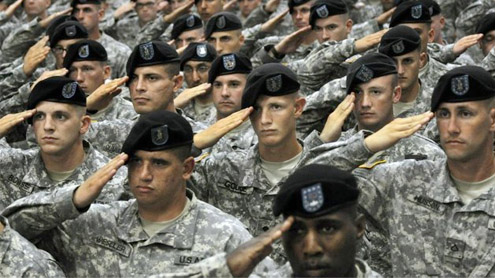
WASHINGTON: The Army will eliminate at least 12 combat brigades, relocate thousands of soldiers and cancel $400 million in construction projects as the first wave of federal budget cuts takes aim at military communities around the country.
In a massive restructuring, Army leaders said Tuesday that they will slash the number of active duty combat brigades from 45 to 33, as the service moves forward with a longtime plan to cut the size of the service by 80,000. And they warned that more cuts — of as many as 100,000 more active duty, National Guard and Reserve soldiers — could be coming if Congress allows billions of dollars in automatic budget cuts to continue next year.
The sweeping changes would eliminate brigades — which number from 3,500 to 5,000 troops — at 10 Army bases in the U.S. by 2017, including those in Texas, Kentucky, Georgia, Colorado, North Carolina, New York, Kansas and Washington. The Army will also cut thousands of other jobs across the service, including soldiers in units that support the brigades, and two brigades in Germany have already been scheduled for elimination.
Gen. Ray Odierno, Army chief of staff, said one additional brigade will likely be cut, but no final decisions have been made.”I know in the local communities it will have its impact,” Odierno told reporters Tuesday. “But we’ve done our best to reach out to them so they understand what the impacts are. We’ve tried to make it as small an impact as possible for as many communities as we could.”Members of Congress, meanwhile, expressed concerns about the prospects for greater cuts down the road.
Rep. Howard P. “Buck” McKeon, R-Calif., chairman of the House Armed Services Committee, said his panel “will carefully examine the implications of this initial restructuring, but we all must understand that this is only the tip of the iceberg, much deeper cuts are still to come.”The Army is being reduced in size from a high of about 570,000 during the peak of the Iraq war to 490,000 as part of efforts to cut the budget and reflect the country’s military needs as the wars in Iraq and Afghanistan end. Odierno said that the potential 100,000 more would be spread out across the active duty, Guard and Reserves, and that there also could be reductions in the Army’s 13 aviation brigades.
While the personnel cuts may have less impact at some of the Army’s larger bases such as Fort Hood in Texas and Fort Bragg in North Carolina, they could be more painful for communities around some of the smaller installations such as Fort Knox, where currently only one brigade is based.The other seven U.S. bases that will lose a brigade are: Fort Bliss in Texas, Fort Campbell in Kentucky, Fort Carson in Colorado, Fort Drum in New York, Fort Riley in Kansas, Fort Stewart in Georgia, and Joint Base Lewis-McChord in Washington. Soldiers in the deactivated brigades would be transferred to other units.
Odierno said the Army tried to spread out the cuts geographically. He said Fort Knox scored the lowest in military value, but insisted the reduction was not the first step toward closing the base. He noted that about 4,000 civilians workers had been added there, as well as the Army’s recruiting command.The overall cut in size has been known for more than a year, and Army leaders have been working on how to manage the reduction, conducting local community meetings across the country and releasing an extensive study on the issue earlier this year.
Under the plan announced Tuesday, the Army will increase the size of its infantry and armor brigades by adding another battalion, which is between 600-800 soldiers. Adding the battalion was a recommendation from commanders in Iraq and Afghanistan who said it would beef up the fighting capabilities of the brigades when they go to war.
Odierno said he continues to hope that he will be able to cut the 80,000 soldiers largely through voluntary departures. He said he believes he will have to force several hundred officers to leave in order to get the proper number of soldiers at various ranks. But, if the automatic cuts go forward, Odierno said he would likely have to force soldiers out of the Army.
These initial brigade cuts do not affect National Guard or Reserve units.Officials said the decisions on the cuts were based on a variety of factors including required training resources, ranges, air space and infrastructure, as well as the need to put units near leadership and headquarters units. – YahooNews












